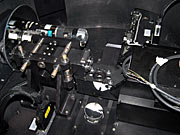Announcement
World's Most Precise Stellar Spectrograph Gets Polarised Vision
15 February 2010
The very successful HARPS spectrograph, attached to ESO's 3.6-metre telescope at La Silla, Chile, has just been enhanced with a new capability: the world's most precise polarimeter for the study of stars.
Polarisation describes the preferential direction in which light vibrates as it travels and it is measured with a polarimeter. The first observations with the HARPS polarimeter show that this new capability already exceeds expectations [1]. Furthermore, it is the only polarimeter of its kind in the southern hemisphere, opening up almost half the Universe to new studies.
Nikolai Piskunov from Uppsala University in Sweden and Principal Investigator of the HARPS polarimeter project is enthusiastic: “This new, unique polarimeter opens up exciting new windows for studying the origins and the evolution of magnetic fields in stars of various masses, temperatures and ages. It is also important for the discovery of new exoplanets: The capability to diagnose starspots will be crucial to rule out fake exoplanet detections.”
According to our current picture of the Universe, magnetic fields play fundamental roles on various scales from planets to galaxies. In particular, magnetic fields are believed to control the way stars form, create favourable conditions for planet growth around young stars, steer stellar winds and accelerate particles during the final stages of a star’s life.
The indirect signatures of magnetic fields can be obvious (such as flares or spots on the surface of stars), but direct measurements require precise instrumentation and careful data analysis. Polarimetry looks for the polarised light resulting from magnetic fields.
Magnetic fields modify the physical conditions in the outer layers of stars giving rise to regions with different chemical composition, temperature and pressure. Sunspots are the best known examples of such action. Utilising the combination of precise spectroscopy and polarimetry, it is possible to map these starspots.
The HARPS spectrograph is already the world’s most successful exoplanet hunter. To date, this instrument has detected nearly 100 exoplanets by precisely measuring the wobbling effect in spectra of stars under the gravitational pull of their planets. The new instrument mode for HARPS makes it capable of also measuring the polarisation of stellar spectra, and allowing it to study magnetic fields on stars.
The polarimeter was designed by Frans Snik from Utrecht University, the Netherlands. The instrument was shipped to Chile in May 2009, and it is now officially ready for use by the astronomical community. “The space we could use for the polarimeter was very small,” says Snik. “Therefore the design had to be very compact. In the end, everything fit to within a fraction of a millimetre between the other elements of HARPS. We were absolutely not allowed to touch those, because that would disturb the successful planet-finding campaigns.”
The HARPS polarimeter was developed by a consortium consisting of Uppsala University (Sweden), Utrecht University (the Netherlands), Rice University and Space Telescope Science Institute (USA), with support from ESO and Geneva Observatory (Switzerland).
Note
[1] The HARPS polarimeter can detect the polarisation of light at a level as small as 1 part in 100 000, without any disturbances from the Earth’s atmosphere and the instrument itself. Together, with the unprecedented stability of the spectrograph, this makes HARPS the most precise instrument of its kind.
Contacts
Nikolai Piskunov
Dept. of Physics and Astronomy, Uppsala University, Sweden
Phone: +46 18 471 5958
E-mail: piskunov@fysast.uu.se
Frans Snik
Utrecht University, The Netherlands
Phone: +31 30 253 5218
E-mail: f.snik@uu.nl
Henri Boffin
ESO ePOD
Phone: +49 89 3200 6222
E-mail: hboffin@eso.org
About the Announcement
| Id: | ann1005 |

